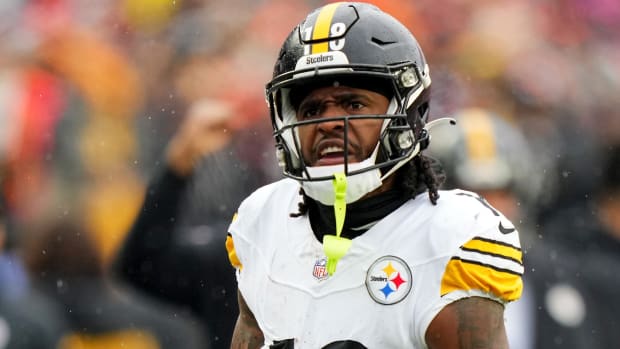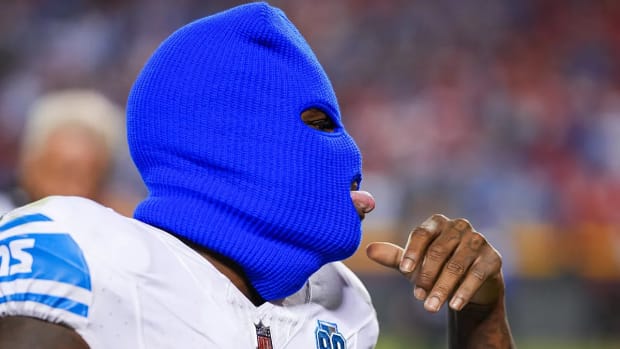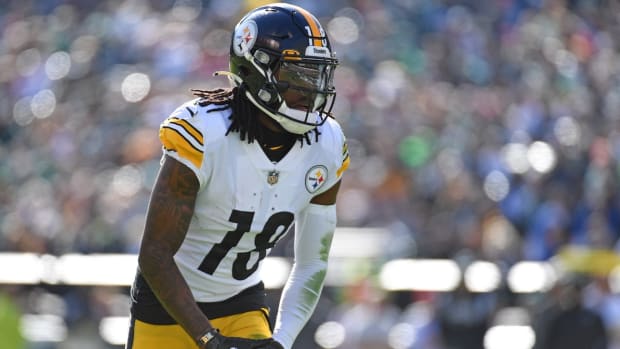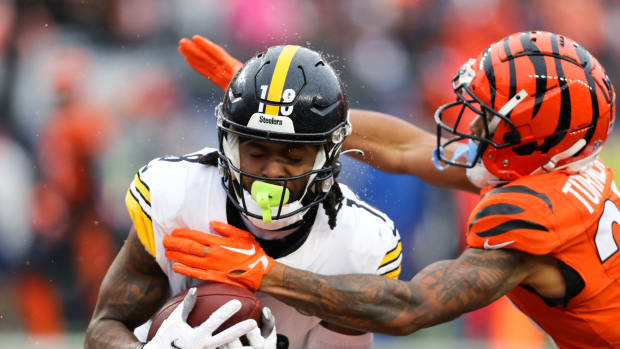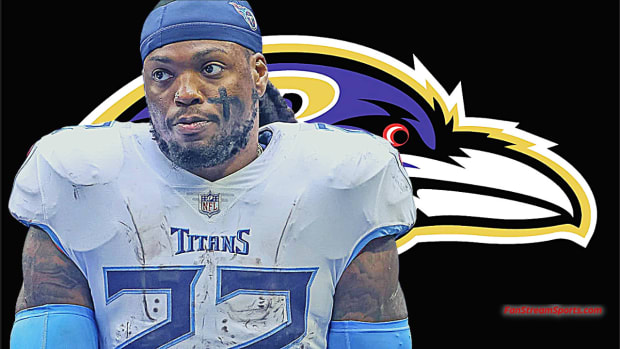Worth The Wait: Patience Without Panic Helps Chris Ballard Find Frank Reich to Lead Colts
As Colts GM Chris Ballard left Lucas Oil Stadium on Tuesday—his six-week, two-chapter coaching search complete—one thought came over him, with Frank Reich in place as Indianapolis’ new head coach and Reich’s introductory press conference in the books. Ballard laughed a few minutes later recalling it.
Why didn’t I interview him in the first place?
It wasn’t supposed to be this way. Ballard and Patriots offensive coordinator Josh McDaniels spent dozens of hours over the past year forging a relationship and, essentially, vetting one another. And while, as Ballard said, McDaniels was just one of five to interview during wild-card week, and McDaniels also interviewed with the Giants and Bears, the sense from the start was that this one was in the bag.
All of that seems like it happened a long time ago now.
Ballard went from picking a guy he got to know in what became a one-horse race to finding another coach he never met off his “B” list. Crazy? Maybe. But the truth is, what the Colts GM was looking for in a coach didn’t change much between Dec. 31, the last day of Indy’s season, and Feb. 11, when the Reich hire became official. Circumstances did.
“The biggest thing, talking with Jerry Angelo, Bill Polian, Tony Dungy, all three, to a man, it was patience, don’t panic, stay poised if you lose a coach you like,” Ballard explained Tuesday night. “That stuck with me throughout all this, from all three of them. If you lose a coach you like, don’t panic, there’s gonna be a right fit for the organization. It really resonated with Josh saying no, and saying he was staying in New England.
“And when we opened it up, we had eight guys that we wanted to interview, and we had 3 guys left that we hadn’t interviewed. So when we decided to go to the rest of the guys, it resonated again, to have patience, keep doing what you were doing in the interviews, and you’ll find the right candidate. Their advice, their words, it makes more sense now with Frank.”
In this week’s Game Plan, we’re pushing forward to the offseason. We’ll look at the franchise tag seemingly returning to its intended purpose; dive deeper into the Jimmy Garoppolo contract; examine where things stand, realistically, with Johnny Manziel’s attempted comeback; explain why the Patriots were so motivated to keep Josh McDaniels; and much more.
But we’ll start with the Colts’ strange month, and how Ballard (now in Year 2 of his rebuild) and the organization have come out of it. So let’s lay out where the Colts were nine days ago, when McDaniels backed out of his deal.
During the first round of interviews, the Colts talked to Chiefs offensive coordinator Matt Nagy, Seahawks defensive coordinator Kris Richard, Texans defensive coordinator Mike Vrabel and Baylor coach Matt Rhule. Nagy wound up taking the Bears job, Vrabel (an Indy finalist) got the Titans job, Richard moved on to Dallas as an assistant, and Rhule pulled his name out of the running.
That left Ballard three names from his list that he hadn’t interviewed. New Orleans assistant head coach Dan Campbell and Buffalo defensive coordinator Leslie Frazier weren’t available during the first week of the playoffs, per the rules, with their teams were playing. And by the time that weekend came, Indy’s search was basically over, so Campbell and Frazier weren’t called.
So it was natural that Campbell and Frazier got calls the second time around. What’s harder for Ballard to wrap his head around, as he thought on Tuesday’s ride home, is why Reich didn’t get an interview during the Eagles’ bye week.
“People act like these head coach searches are an exact science; they’re not,” Ballard said. “Just look at the turnover in our league. Head coaches, GMs too, it’s tenuous, guys are two, three years on the job, and teams are moving on. There’s risk with every team that’s hiring. I wouldn’t say there are many no-brainers in the group, in any year.”
Ten Things I Think I Think About Frank Reich, the Colts’ New Head Coach
Reich certainly wasn’t one. He interviewed for openings with the Jets and Bills in 2015, but was fired as Chargers offensive coordinator the following January. And in Philly, Doug Pederson calls the plays, and quarterbacks coach John DeFilippo, at least in the early stages of this year’s hiring cycle, generated more head-coaching heat than Reich, who didn’t get a single interview before coming to Indy.
That meant it’d take some work, the kind Ballard and the Colts had already done on McDaniels, to see what was there.
Once the GM got going on that, relying on three former co-workers of Reich’s, things started to turn. Polian told Ballard the story of how, after Reich’s rookie year (1985), Polian said to him, “Listen, you’re gonna be a coach in this league—a head coach in this league—if that’s what you want to be.” Dungy, who broke Reich into the NFL as a coach, explained how Reich’s consistent, steady nature leant itself to being a head coach.
And then there was Pederson, whom Ballard worked with for three years in Kansas City. “He told me Frank is very smart, and he was Doug’s right-hand man. And look, I trust Doug,” Ballard said.
What was left was the interview, and seeing whether or not Ballard could connect with Reich like he had with McDaniels. It took 15 minutes—enough for Reich to detail his family’s coaching history, his business experience and his time in a seminary—for Ballard to feel the kind of rapport that’ll be vital to where this all goes.
“Jerry (Angelo) and Lovie (Smith), I got to be a part of one for nine years (in Chicago). That was a heck of a partnership. And I always thought Andy (Reid) and John (Dorsey) worked well together during my time in KC,” Ballard said. “It’s hard to do, if you’re not on the same page philosophically in the way you want to play the game. And you have to have a guy that respects you and your work, and you respect him and his work.
“As (Reich) talked about the way he saw our team playing, the way we should build our team, it was a good match. It was a really good match.”
Wristband 145: Behind The Play That Confused The Patriots and Gave The Eagles The Super Bowl LII Win
On offense, as Ballard explains, that’ll mean being up-tempo and matchup-based. On defense behind coordinator Matt Eberflus, it means being fast and athletic. That’s not much different than what Ballard’s been looking for all along in a guy who has to be the right kind of leader before the scheme discussion even starts.
“People say no in this league all the time,” Ballard points out, as a way of explaining that vacillating or changing what you’re looking for can lead a team down a murky path. “That’s when you make bad decisions in my mind.”
So Ballard stuck to his guns, and it’s led the Colts here. And he’ll walk away from this most unusual coaching search with a couple of lessons to file away.
“Be careful who you listen to, number one,” he said. “You develop relationships through the years with some very experienced people, you need to keep the line with those people. When you let your scope get too broad, listening to too many people, that’s not always a good thing. And then, to build a good football team, and to do things the right way, you’re gonna have some difficult moments along the way.
“You have to get through those, and you just gotta keep believing in what you believe in, keep your integrity along the way, keep doing the right thing. And things work out, they do. I believe that.”
Maybe Reich will work out. Maybe he won’t. For now, Ballard’s at peace with the process, because it did lead him to a seminal moment, as he wrapped up Reich’s interview. On his way out of the room, Ballard texted Polian, who’d been a champion for Reich to both Ballard and owner Jim Irsay, with a question: How is this guy not a head coach already?
It took six weeks for the GM to get there. Suffice it to say, it was worth the wait.
NFL Free Agency 2018 Guide and Tracker: Suh to the Rams
FIRST AND 10
1. We should recognize here the decision by Oakland to part ways with Sebastian Janikowsi, the only kicker of my lifetime to be drafted in the first round. Janikowski lasted 18 years with the Raiders, which is pretty incredible and validates their controversial decision to draft him that high. Only two other players from that draft are still active. One was taken 182 picks after Janikowski. That’d be Tom Brady. And the other? Another special-teams pick by Oakland—fifth-round punter Shane Lechler, who played for Houston last year.
2. Jeremy Bates was officially promoted to offensive coordinator in New York on Wednesday, and that should help the Jets in their pending pursuit of KirkCousins, who’ll be looking for a fit and could find one with an OC from the same tree as Kyle Shanahan and Sean McVay. Both coaches, should they be asked, could also effectively help out the Jets with Cousins by putting in a word for Bates.
3. By the way, if the Redskins attempt to franchise Cousins, my understanding is that his camp will quickly file a grievance to block tag, based on Washington violating the spirit of the rules, which dictate that players are tagged as a mechanism for teams to buy time in getting a long-term deal done.
4. One other thing on Cousins: if Denver’s going to be involved, they’ve got some serious massaging of the salary cap coming in the next few weeks. Aqib Talib, Derek Wolfe, Demaryius Thomas and Emmanuel Sanders each count eight figures against the cap next year, and only the injury-ravaged Wolfe is on the right side of 30.
5. LSU corner Donte Jackson may have seemed to be boasting earlier this week when he set a goal to break John Ross’ record in the 40 in Indy, set last year, then added that he expects to clock in the 4.2s. But the fact is, few scouts would be shocked if he did. Jackson was generally regarded as one of the fastest players in college football last fall.
The 2018 NFL Draft Big Board, Vol. 1
6. Bengals QB AJ McCarron may have a ruling on his grievance by the time you read this, and he’d be another interesting name to have out there on the market, if he’s unrestricted. It’d hardly be a surprise to see Cleveland or Denver to try and sign him to be the for-now starter ahead of a rookie, like MikeGlennon was supposed to be last year in Chicago.
7. On several occasions, new Giants offensive coordinator Mike Shula and I have discussed the amount of study he’s done in the last few years of college spread offenses, in part to try and find ways to most effectively use Cam Newton. Now that Shula is in New York, you’d wonder if that might open up the possibility that the Giants seriously kick the tires on Baker Mayfield.
8. If the Saints have another strong year, I’d expect Dan Campbell will be a very serious candidate to become a head coach in 2019. He’s come highly recommended by the people who worked for him during the Dolphins’ 2015 dumpster fire, during which he took over as interim coach.
9. Give Chargers coach Anthony Lynn credit for allowing receivers coach Nick Sirianni to pursue and win the Colts offensive coordinator job under Reich this week. Lynn was blocked from pursuing coordinator jobs a couple times as an assistant, which was frustrating for him at time. As a result, he believes strongly that head coaches should not stand in the way of their lieutenants’ advancement.
10. The rap on Reuben Foster coming out of Alabama was that he was sheltered in Tuscaloosa and ran with a tough crew from back home, which led to concerns on how he’d operate outside the cocoon and contributed to his draft-day plunge. You can consider those concerns valid.
FOUR DOWNS
1. Franchise tag getting closer to intended purpose. Six years ago, at the outset of the current collective bargaining agreement, I had an agent refer to the franchise-player designation as the “prison tag.” And he had a point: Tons of teams were using the tag to hold players with no intention of doing long-term deals. Back then, tags were affordable and an effective mechanism for keeping valuable players off the market. Now? Things have changed. With a rising cap, and bigger contracts resulting, the tide has risen.
So based on calculations off a $178 million cap (it’s expected to be higher than that, but that’s the working number teams were given), here are projections for the 2018 tags:
CB: $15.04 million
DE: $17.22 million
DT: $14.00 million
LB: $15.03 million
OL: $14.14 million
K/P: $4.96 million
QB: $23.29 million
RB: $11.90 million
S: $11.34 million
TE: $9.90 million
WR: $16.05 million
Put these numbers into practice, and you’ll see why teams rarely tag good-not-great players anymore, and why they have to think hard even with their very best. Lions pass rusher Ziggy Ansah is a good example. His rookie deal expires next month, he’s coming off his second double-digit sack season, and he’s an athletic freak who, at 28, still has untapped upside. But to tag him, it’d cost $17.22 million. That means two tags (the second is 120 percent of the first) would be close to $38 million, which means Ansah wouldn’t be out of line asking for $18 million or $19 million per year. That would make him the second highest paid edge rusher in football, behind Von Miller. The alternative? Let Ansah, with a premium skill that isn’t easily found, hit the market with no guarantee he’ll come back. Or let him play out the season on the tag, something that’s not as much of a non-starter for players as it used to be—Kirk Cousins and Le’Veon Bell have done pretty well for themselves in that circumstance.
So just remember as the Lions make a call on Ansah, and the Seahawks on Sheldon Richardson and Cowboys on DeMarcus Lawrence, that these tags aren’t as team-friendly as they used to be.
2. Cleaning up the Garoppolo deal. Here’s what I found most interesting about the negotiation of 49ers QB Jimmy Garoppolo’s five-year, $137.5 million deal—there was almost no acrimony. Talks began the day after San Francisco’s season ended, and it took a little over a month to find the finish line.
“What was interesting was neither one of us even talked about the franchise tag, or using it as a floor, or as a ceiling,” 49ers EVP of football operations Paraag Marathe told me. “We both knew it was there, and understood it was an option. But neither side used it as a chip. It was a positive negotiation, we knew the market, and we knew we were ahead of it. … We just wanted to keep the conversation free of that. We didn’t want it to have negative framings. We wanted it to have positive framings.”
Of course, it’s not a coincidence that the average per year ($27.5 million) landed right around what the exclusive tag, which isn’t calculated until April, will likely cost. But the team didn’t threaten to hold him over for a year, and Garoppolo’s camp didn’t force the team to tag him, which made this one as easy as it could’ve been.
Jimmy Garoppolo’s New Deal: Kyle Shanahan on How the 49ers’ QB Earned His Contract
As for the deal itself, there were a couple things that I found interesting in the details. First, the Niners decided to use the cap room they have now to give themselves future flexibility. Garoppolo’s cap number for 2018 is $37.0 million, which is $10 million more than any of the future figures—it’s $20.0 million for ’19, $26.6 million for ’20, $26.9 million for ’21, and $27.0 million for ’22. Garoppolo got $35 million to sign, but $28 million of that was payable in a roster bonus due in March, which gets the quarterback his money up front and drops the whole figure on to the 2018 books, rather than spreading it out like a signing bonus would. (The remaining $7 million was paid to Garoppolo in the form of a signing bonus, which will be prorated). And Marathe said he’d have put even more into Year 1, if not for the little-known 50/50 rule, which compels teams to make the Year 2 cap figure at least 50 percent of the Year 1 figure.
Second, even though the Niners did drop 27 percent of the cap dollars into 2018, they still have a ton of financial freedom this offseason. Accounting for draft picks and IR contingency money, as well as Garoppolo’s new money, the Niners still project to have around $63 million to spend in free agency. So they’ll go into this offseason with a quarterback they believe in, and a ton of options for what’s to come in March.
3. Eagles’ flight plan plays the numbers. The world champions may not have the largest analytics department in football, but there are few that have as rich a history in that area or apply the numbers as often as the Eagles do. And the markings of it are all over the roster that took out the Patriots 11 days ago.
The first one to point out was a study the Eagles did correlating youth and health in younger free agents. It drew them to linebacker Nigel Bradham, safety Rodney McLeod and guards Brandon Brooks and Stefen Wisniewski. All four have played in at least 30 regular season games since being signed as free agents in 2016, and each was healthy and starting for the playoff run, which helped offset some of the bad injury luck (Carson Wentz, Darren Sproles, Jordan Hicks, Jason Peters) that hit the Eagles this year.
The second one involved rookie Derek Barnett, acquired with the pick that Philly got for Sam Bradford. Some assumed that because Barnett was considered pedestrian athletically that analytics people wouldn’t like him. But the Eagles’ data said something else. Philly saw his 10-yard split in the 40 as a tell that he had the physical ability to translate to the NFL. And on a per-play basis, Barnett was the most productive pass rusher in America during his final season at Tennessee. Barnett, you may remember, recovered Tom Brady’s fumble on Brandon Graham’s Super Bowl-winning strip sack.
The third one involved the reacquisition of Nick Foles. The Eagles wanted to avoid a situation like Dallas had in 2015—a loaded team that couldn’t weather a quarterback injury—and they saw Foles as undervalued, because of his short-lived run with the Rams. The limited exposure Foles had in Kansas City, in their view, approximated closer to what he had been in Philly (a low level starter/high level backup) than what he’d been in St. Louis or Los Angeles. And the Eagles’ willingness to over-invest in the position opened the door to sweep Chase Daniel out and get back Foles.
That last one, of course, shone brightest. But it’s pretty clear that, in a year in which Cleveland’s grand analytics experiment died, the Eagles were able to effectively meld what they do into traditional scouting and coaching behind their analytics chief, Alec Halaby, and with the support of EVP of football operations Howie Roseman.
Chris Long’s Next Mountain: After Super Bowl Summit, Eagle Eyes Kilimanjaro For Water Charity
4. Johnny’s got a long way to go. Credit to former first-round pick/Heisman winner Johnny Manziel for going public with his problems this week. It was refreshing to hear him take blame for his mistakes in Cleveland to Barstool’s Pardon My Take podcast and open up about being diagnosed with Bipolar disorder on Good Morning America. But let’s be clear: Manziel has a long way to go to get an invite to an NFL camp.
“It only takes one team but I’ll be dumbfounded if it happens,” said one AFC exec on Wednesday night. “Watching him, listening to the interviews, none of it sounds real. Nobody trusts him, he’s been so full of it. That was what was great about him, is he could bullsh-t and get along with anyone. But what you eventually figured out was it’s all BS.”
This is take is not unique among NFL evaluators, and that means finding a way to rebuild any trust left with teams will be a vital first step for Manziel. From there, he’d likely have to put something on tape, and so going to the Spring League to get two games in April can’t hurt. After that, my guess is Mazniel will have to play in Canada to prove to teams that his juices for the game are still flowing. If he can, you might seem him get a shot. But there certainly aren’t any sure things here.
LESSON OF THE WEEK
We started the column with the place Josh McDaniels left behind, and we’ll end with where he’s staying—and one reason why Robert Kraft had for making that happen.
In last week’s column, I explained how the Krafts always want certainty, and abhor the idea of going year-to-year, in running their franchise. That, without question, was part of their decision to aggressively pursue what seemed, at the time, like a remote possibility that they could keep McDaniels.
But there’s also the realization that they’ve only got so much Tom Brady left, and therein lies the Lesson of the Week: There’s nothing more important than creating the right environment for your franchise quarterback.
And as Brady has gotten older, and more experienced, that’s become more difficult, because the more he learns, the harder it becomes to give him anything new or challenge him in new ways. The idea, of course, is always for a coach to come to the table more prepared than a player, which becomes a hurdle to clear for anyone teaching Brady.
“He’s a challenging guy to coach because his aptitude is so significant,” McDaniels told me during Super Bowl week. “He’s a tremendous player as far as coming every day ready to work and ready and willing to learn. That pulls the best out of you as a coach because you can’t go into the meeting room and not challenge this guy to try and get better.
“Here’s a guy, he’ll go down as what he’ll go down as, which is one of the greatest players ever to play in this game, but he still comes into every meeting looking for something that’s going to make him a better player that day. And as a coach, you have to respond accordingly, whether it’s making sure you provide him with that information or you find something to help him improve some aspect of his game.”
I remember asking Bill O’Brien about that dynamic awhile back, and he relayed what Brady told him when McDaniels went to Denver in 2009 and O’Brien became the play-caller and quarterbacks coach: I want to be coached.
O’Brien viewed it as a challenge that he had to find a way to surmount.
“You have to be so on top of your game,” O’Brien said. “It takes extra work. It takes getting in early and staying late to make sure that when you go into a meeting with him, you’re not wasting his time. If you think you’ll go in there and tell him something he’s known since his rookie year about a running play or a protection or some type of coverage, then you’re way off base.
“You’ve gotta make sure you’re going into each meeting preparing him for what he’s gonna see, and showing him things you see one way, and he may see a different way, while you’re trying to get on the same page in how you see it. You’ve gotta be really on top of your game. … That made us better coaches, because of how prepared we had to be to coach him.”
So how does this play into the Kraft’s decision-making? Well, one big question when it was assumed McDaniels would be gone was how the infrastructure around Brady would be rebuilt. He’s had three coordinators running the same system in his 18 years (Charlie Weis, McDaniels, O’Brien) and a handful of position coaches. Compounding the problem was the likelihood, a few weeks ago, that McDaniels would take assistant QBs coach Jerry Schuplinski with him.
The belief for some time has been that receivers coach Chad O’Shea, himself a college quarterback, would succeed McDaniels. But O’Shea hasn’t coached the position in his 23 years in the profession, 16 of which have been in the NFL. And the Patriots didn’t have a logical solution on staff to work with Brady.
Maybe they could’ve brought back Weis, but the fact is that all of the above added plenty to McDaniels’ value inside the building, as did his ability to serve as a buffer between Brady and Bill Belichick.
In the end, the Kraft saw that value. And chances are, they have this one nipped in the bud, with there being a good chance McDaniels is there for the rest of Brady’s career.

































